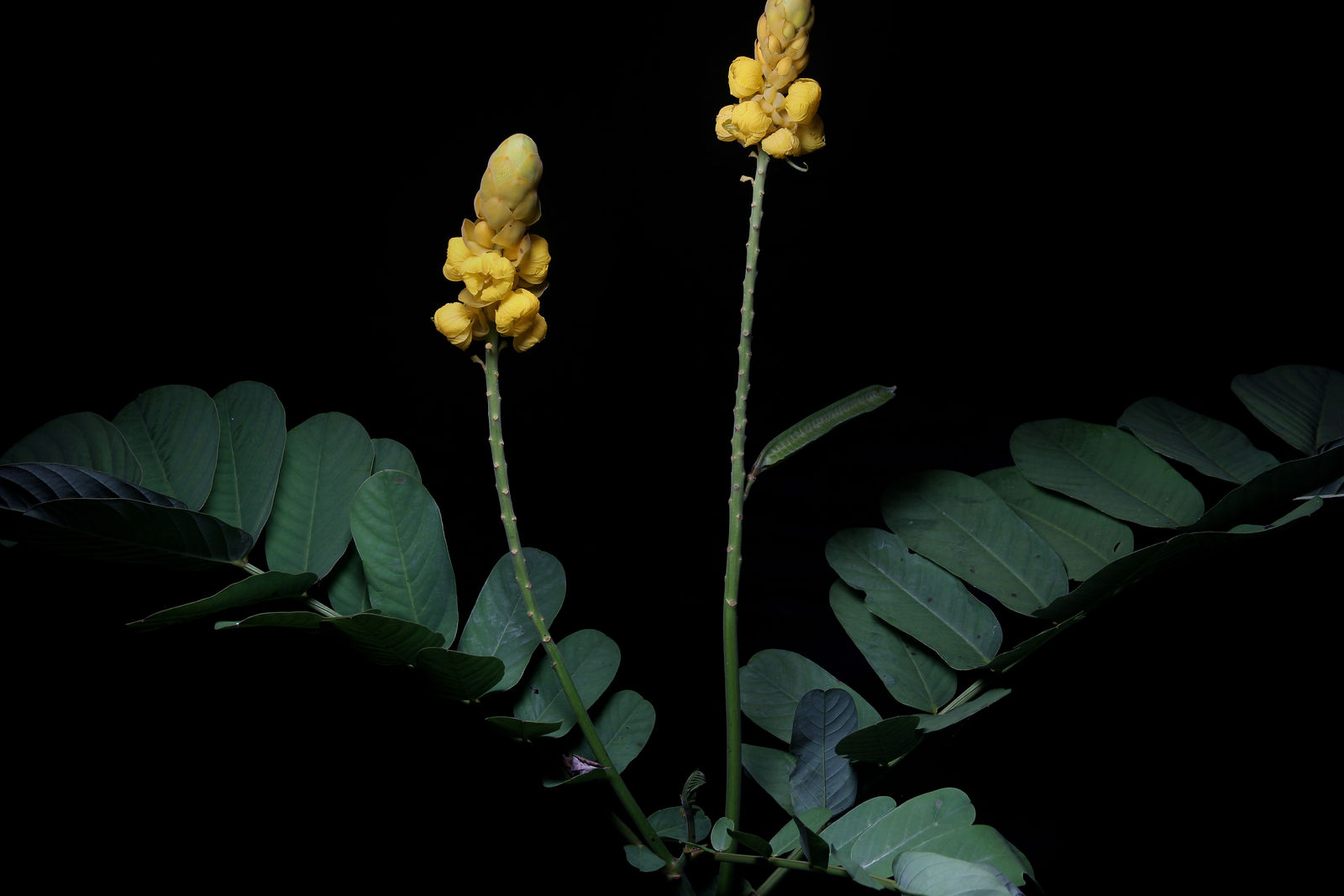Candlestick Senna, Candle Bush
senna alata
Also known as: ["Candlestick Senna","Candle Bush","Emetic Nuts","Rising Sun Senna"]
Overview
A tropical shrub known for its bright yellow, candle-like inflorescences and medicinal properties.
Benefits & Perks
["long-flowering","wildlife attractant (bees, butterflies, birds)","drought tolerant"]
Botanical Classification
| Phylum: | Magnoliophyta |
| Class: | Magnoliopsida |
| Order: | Fabales |
| Family: | Fabaceae |
| Genus: | Senna |
| Botanical Name: | Senna alata |
Plant Characteristics
Basic Information
- Category: Flowers
- Suitable Location: outdoor garden bed in tropical or subtropical regions
- Suitable For:
- Is Weed: No
- Allergenicity: low
Environmental Needs
- Climate: {"temperatureRange":"15–35°C"}
- Hardiness: {"zones":"9–11"}
- Misting: rarely required, only if ambient humidity is very low
- Drainage: Fast-draining to prevent waterlogging.
- Soil Type: Well-draining, loamy soil with organic matter; can tolerate sandy or slightly acidic soils.
Maintenance Level
- Maintenance Level: moderate
- Toughness Level: moderate
- Pruning Frequency: Annually in late winter or early spring; light pruning can be done as needed year-round.
- Pruning Intensity: Moderate; remove up to one-third of the plant if overgrown, but avoid heavy pruning in dormant perio
Care Details
Ideal Sunlight Coverage:
Full sun to partial shade; 6–8 hours of direct sunlight daily, with some afternoon shade in hot climates.
Sunlight Tolerance Tips:
Acclimate new plants to sunlight gradually; protect from intense midday sun to avoid scorching; adjust placement based on indoor/outdoor conditions.
Care Requirements
Care Difficulty
moderatemoderate
Sunlight
full sun to partial shade
Rotate plant for even growth; use sheer curtains to filter intense light; avoid direct sun through glass in summer.
Watering
every 7–10 days during active growth, reduce in winter
Water thoroughly until it drains from the bottom; allow soil to dry between waterings; avoid overwatering.
Soil
well-draining, loamy soil with organic matter
pH: Slightly acidic to neutral, pH 6.0–7.0.
Use a cactus mix as a base; avoid heavy clay soils; topdress with compost annually.
Temperature
Thrives in warm conditions, 65–85°F (18–29°C); prefers stable temperatures and dislikes frost.
Avoid sudden temperature changes; protect from frost; ensure good air circulation in hot weather.
Fertilizing
every 4–6 weeks during growing season with balanced liquid fertilizer
Fertilize only when actively growing; flush soil occasionally to prevent salt buildup; avoid overfertilizing.
Propagation
Methods
Stem cuttings or seeds; stem cuttings are more common for home growers.
Step-by-Step Propagation Guide
- Take a 4–6 inch cutting.
- Remove lower leaves.
- Apply rooting hormone.
- Plant in medium.
- Keep moist and warm.
Best Time: Spring or early summer when the plant is actively growing.
Environment
Warm, humid environment with indirect light; maintain consistent moisture.
Medium
Well-draining potting mix with perlite or sand; can also root in water initially.
Hormone
Rooting hormone is recommended to improve success rates.
Timeline
Roots may develop in 3–6 weeks; new growth typically appears after 2–3 months.
Tools Needed
Pruning shears, rooting hormone, small pots, well-draining mix.
Quick Tips
Use healthy, non-flowering stems; keep cuttings out of direct sun; maintain humidity with a plastic bag if needed.
Pruning & Repotting
Pruning Guide
Method
Use clean cuts just above a leaf node or branch junction; remove crossing or crowded branches.
Pruning Plan
Prune to maintain shape, encourage bushier growth, and remove dead or diseased parts.
Tools
Pruning shears, sterilizing solution, gloves.
Checklist
Sterilize tools; prune dead/diseased parts; shape the plant; clean up debris.
Repotting Guide
Best Season
Spring, before the active growing season begins.
Pot Size
Increase pot size by 2–3 inches in diameter; ensure good drainage holes.
Method
Remove plant gently; trim roots if necessary; place in a slightly larger pot with fresh soil; water lightly.
Suggestions
Repot every 2–3 years or when roots fill the pot; beneficial for growth and soil freshness.
Checklist
Check root bound status; prepare new pot with drainage; trim roots if needed; use fresh soil.
Advanced Care Tips
Watering Mastery
Watering Checklist
Check soil moisture; water deeply; ensure drainage; adjust for season.
How to Apply Water Properly
Water at the base of the plant, ensuring moisture reaches the root zone; water early in the morning to minimize evaporation; ensure excess water drains away to prevent waterlogging.
Watering Schedule Tips
Water deeply once the top inch of soil feels dry; reduce frequency in winter to prevent root rot.
Soil Improvement
Add perlite or coarse sand for drainage; incorporate compost for fertility; ensure good aeration.
Temperature Stress Management
Signs of Temperature Issues
Yellowing leaves, wilting, or leaf drop in cold; scorching or stunted growth in excessive heat.
Cold Stress
Growth slows or halts; leaves may turn yellow or drop; risk of frost damage in temperatures below 50°F (10°C).
Solution: Move to a warmer location; protect with a frost cloth; avoid cold drafts.
Hot Stress
Leaves may scorch, wilt, or drop; growth may slow due to excessive heat and water loss.
Solution: Provide shade during peak heat; increase watering; use mulch to retain soil moisture.
Fertilizing Guide
Fertilizing Checklist
Check growth phase; dilute fertilizer; apply to moist soil; rinse pot periodically.
Fertilizing Method
Use a balanced liquid fertilizer diluted to half strength every 4–6 weeks during growing season (spring/summer); reduce or stop in fall/winter.
Common Problems & Solutions
Toxicity Warning
Cats
Slightly ToxicCats are sensitive to anthraquinone glycosides, which can cause mild to moderate gastrointestinal distress upon ingestion. The plant is not typically considered highly toxic but can cause discomfort.
⚠️ Symptoms:
🌿 Toxic Parts:
⚡ Toxic If:
if eaten
Dogs
Slightly ToxicIn dogs, ingestion of Senna alata can lead to mild gastrointestinal upset due to the presence of anthraquinone glycosides. The effects are generally not life-threatening but can cause discomfort.
⚠️ Symptoms:
🌿 Toxic Parts:
⚡ Toxic If:
if eaten
Humans
Slightly ToxicSenna alata contains anthraquinone glycosides, which can act as laxatives and may cause gastrointestinal irritation when ingested in significant quantities. The physiological impact is primarily localized to the digestive system.
⚠️ Symptoms:
🌿 Toxic Parts:
⚡ Toxic If:
if eaten
Frequently Asked Questions
Q: Is Senna alata toxic to pets?
A: Yes, it is mildly toxic to dogs and cats if ingested.
Q: Does Senna alata attract wildlife?
A: Yes, it attracts bees, butterflies, and birds due to its bright flowers.
Q: How often should Senna alata be watered?
A: Water moderately, allowing the soil to dry slightly between waterings; it is drought tolerant once established.
Quick Reference
| Family: | Fabaceae |
| Care: | moderate |
| Light: | full sun to partial shade |
| Water: | every 7–10 days during activ |
Get Expert Care Tips
Download the Plantious app for personalized care reminders and plant identification!
Google Play App Store








